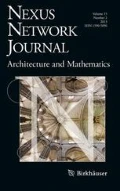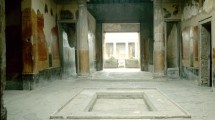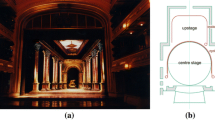Abstract
Architectural historians describe Adolf Loos’s 1928 Moller House as having an interior spatial arrangement that constructs unequal or asymmetrical visual interactions between inhabitants, putting some on display and positioning others as observers. However, there is disagreement about the specific way the Moller House creates these relationships. This paper uses the ASVI computational technique to mathematically test if the spatial and formal properties of the Moller House reflect its four main theorized spatio-visual conditions. In this way the paper develops a new understanding of the spatio-visual experience of this famous early Modernist design.

















Similar content being viewed by others
References
Appleton, Jay. 1975. The Experience of Landscape. London: John Wiley and Sons.
Beek, Johan. 1988. Adolf Loos: Patterns of Town Houses. In Raumplan Versus Plan Libr,ed. Max Risselada, 27-46. New York: Rizzoli.
Bakacsy, Judith, Anne Louise Sommer and Anders V. Munch. 2000. Architecture Language Critique: Around Paul Engelmann. Rodopi Bv Editions.
Benedikt, Micheal. 1979. To take hold of space: isovists and isovist fields. Environment and Planning B: Planning and Design, 6(1): 47-65.
Bourassa, Steven C. 1991. The Aesthetics of Landscape. London: Belhaven Press.
Colomina, Beatriz. 1990. Intimacy and Spectacle: The Interiors of Adolf Loos. AA Files 20: 5-15.
Colomina, Beatriz. 1992. The Split Wall: Domestic Voyeurism. In Sexuality & Space, eds. Beatriz Colomina, Jennifer Bloomer, 73-130. New York: Princeton Architectural Press.
Colomina, Beatriz. 1996. Privacy and publicity: modern architecture as mass media. Cambridge, MA: MIT Press.
Colomina, Beatriz. 2018. The Right of the Modern Nerves. In Adolf Loos: Private Spaces. Barcelona: Editorial Tenov S.L.
Frampton, Kenneth. 1992. Modern Architecture: A Critical History. London: Thames and Hudson.
Frampton, Kenneth. 1996. Adolf Loos as Master Builder. In Adolf Loos: architecture 1903-1932, ed. Roberto Schezen, 14-21. New York: The Monacelli Press.
Foucault, Michel. 1979. Discipline and Punish: The Birth of the Prison. New York: Vintage.
Fisher, Bonnie and Jack L. Nasar. 1992. Fear of Crime in Relation to Three Exterior Site Features: Prospect, Refuge, and Escape. Environment and Behaviour, 24(1): 35-65.
Goffman, Erving. 1956. The Presentation of Self in Everyday Life. Edinburgh: University of Edinburgh Press.
Hanson, Julienne. 1998. Decoding Homes and Houses. Cambridge University Press.
Huangfu, Wenzhi and Wang Leung Thomas Chung. 2019. The Computational Measurement of Prospect-Refuge Perception in Two-dimensional Built Space. In Intelligent & Informed -Proceedings of the 24th CAADRIA, 2: 313-322. Wellington: VUW.
Hillier, Bill. 2003. The architectures of seeing and going: Or, are cities shaped by bodies or minds? And is there a syntax of spatial cognition? In Proceedings: 4th International Space Syntax Symposium, 6.1-6.6.34. London: Space Syntax Laboratory.
Hillier, Bill and Julienne Hanson. 1984. The Social Logic of Space. Cambridge University Press.
Kulka, Heinrich. 1931. Adolf Loos: Das Werk des Architekten. Vienna: Anton Schroll.
Kaplan, Rachel and Eugene J. Herbert. 1988. Familiarity and preference: A cross cultural analysis. In Environmental aesthetics: theory, research and application, ed. Jack L. Nasar, 379-389. Cambridge University Press.
Koch, Daniel. 2010. Architecture Re-Configured. Journal of Space Syntax, 1(1), 1-16.
Le Corbusier. 1925. Urbanisme. Paris. In F. Etchells’s translation of 1929, published under the title The City of To-morrow and its Planning, 185-186. Dover Publications.
Loos, Adolf. 1898. Spoken into the Void: Collected Essays 1897-1900, trans. Jane O. Newman, John H. Smith, 99-103. Cambridge, MA: MIT Press, reprinted in 1982.
Loos, Adolf. 1903. Das Andere, ed. Beatriz Colomina. Zurich: Lars Müller Publishers, reprinted in 2016.
Münz, Ludwig and Gustav Künstler. 1966. Adolf Loos: Pioneer of Modern Architecture. New York and Washington: Frederick A. Praeger.
Ostwald, Michael J. and Michael Dawes. 2018. The Mathematics of the Modernist Villa: Architectural Analysis Using Space Syntax and Isovists. Basel: Birkhäuser.
Stamps, Arthur E. 2006. Interior prospect and refuge. Perceptual and Motor Skills, 103: 643-653.
Turner, Alasdair, Maria Doxa, David O’Sullivan and Alan Penn. 2001. From isovists to visibility graphs: a methodology for the analysis of architectural space. Environment and Planning B, 28(1):103-121.
Xiong, Xiangnan. 2014. The Openness and Intimacy of Interiors of Adolf Loos (路斯住宅空间的公共性与私密性). Journal of Human Settlements In West China (西部人居环境学刊), 29(4): 58-63.
Acknowledgements
All images are by the authors.
Author information
Authors and Affiliations
Corresponding author
Additional information
Publisher's Note
Springer Nature remains neutral with regard to jurisdictional claims in published maps and institutional affiliations.
About this article
Cite this article
Huangfu, W., Ostwald, M.J. & Chung, T. Visual-Asymmetry in Adolf Loos’s Moller House: A Computational Analysis Testing Propositions About Performance and Spectation. Nexus Netw J 23, 57–83 (2021). https://doi.org/10.1007/s00004-020-00481-5
Published:
Issue Date:
DOI: https://doi.org/10.1007/s00004-020-00481-5




